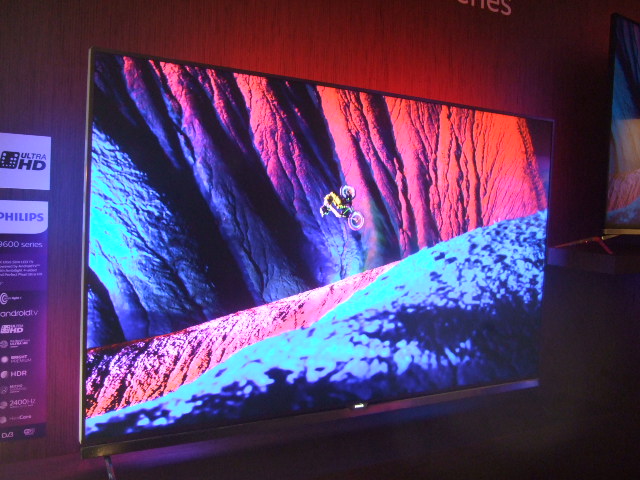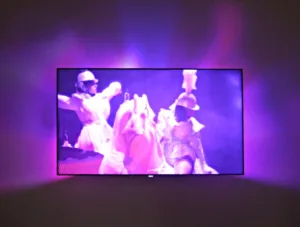Surprisingly, there were no projectors on Philips’ stand this year, so TVs and monitors were the only focus for displays.
 The 9600 is Philips’ new flagship TV: a 65″ model (65PUS9600) with four-sided Ambilight and high dynamic range support. The ‘Bright Premium’ feature can boost peak brightness to 1,000cd/m² (average brightness: 600cd/m²), while direct-LED backlighting and micro-dimming enable control over brightness in individual segments of the display (divided into 240 zones).
The 9600 is Philips’ new flagship TV: a 65″ model (65PUS9600) with four-sided Ambilight and high dynamic range support. The ‘Bright Premium’ feature can boost peak brightness to 1,000cd/m² (average brightness: 600cd/m²), while direct-LED backlighting and micro-dimming enable control over brightness in individual segments of the display (divided into 240 zones).
Android TV runs on a hexa-core processor. Resolution is UltraHD, and the TV can upscale content to this level. Philips has also built its Perfect Natural Motion motion-smoothing technology into the TV. It has 50W sound output, 16GB of storage and supports HbbTV. Two twin tuners (DVB-T/T2/S/S2/C) are built in, and ports for HDMI (x4, supporting UltraHD at 60fps), USB 2.0 (x2) and USB 3.0 are featured.
Philips will begin selling the PUS9600 TV in Q4.
Sound is important in the living room, but too often we rely on poor-quality speakers for our TVs. Therefore the 55″/65″ xxPUS8601 features detachable speakers on the left and right side. The TV features a total of 18 speakers and 50W of sound output. 16 micro-drivers and two built-in Neodymium subwoofers are also featured. A DTS Premium processing suite is used to manage sound.
Four-side Ambilight, UltraHD resolution, micro-dimming and Android TV (running on a hexa-core processor) are also built in to the PUS8601. The TV can reach 700 cd/m² of brightness. It has 16GB of storage, HbbTV, twin tuners and identical ports to the PUS9600. The PUS8601 will be launched in Q4.
A curved model was also shown (55″ and 65″ xxPUS8700), with three-sided Ambilight. It is an UltraHD set, running Android TV on a quad-core processor. No more information was available.
Like the PUS8700, information was very scarce about the 65″ Ambilux 65PUS8900 TV – but we did our best. The unit at IFA was a ‘pre-sample’ model, and specifications – other than the UltraHD resolution – are still being finalised.
The nine projectors in the rear of the set are pico models, with ‘precision technology’ ensuring that images are blended together and there is no overlap. They can be used for video content, or with music streamed through the TV.
A quad-core processor runs Android TV. The unit features 400 cd/m² of brightness, 30W of sound output, 16GB of storage, HbbTV and twin tuners and ports identical to the above models.
We reported on the latest Philips monitors which were pre-announced (Colour and Curves Come to the Fore With Philips at IFA). We also got the chance to catch up with QDVision which was at the show to talk about the first QD monitor to be seen at the show – the 276E6ADS. The 27″ unit has FullHD resolution and is unremarkable in a number of ways. However, the monitor supports 99% of AdobeRGB. The monitor is due to be released shortly (October) in Europe and we heard that the price will be €349, which is a long way below the current products that have that level of colour support. Traditionally, this kind of gamut is achieved with BG/R LEDs. QDVision said that the cost could probably go down as the monitor has 300 cd/m² of brightness because it uses a DBEF. Removing that film would reduce cost and bring brightness and cost down. China may be the biggest early market for this monitor.
Analyst Comment
Our own Ken Werner wrote last week about a potential problem, as he sees it for QD Vision, which is that its technique of putting a tube containing Quantum Dots (QDs) alongside a blue LED edge backlight. That is fine in monitors, which are pretty well exclusively edgelit, but not so good for TVs which are increasingly backlit. QD Vision’s Jim Carlton, an old friend of our editor, told us that although the company would like to be able to address backlit, even the 40% or so of the market that is edge-lit is a pretty good opportunity.
However, the QD Vision approach is to put the QDs close to the LED, but not in it (whereas companies such as Nanosys put the QDs in a film that spreads them over the whole surface of the display). QD materials are relatively volatile (which is why they do what they do), as are OLEDs, and they need protection from oxygen, water and heat. In many ways it would be ideal to build QD LEDs, with the QD on the LED chip itself. On the other hand, that would be too hot. Moving the QDs to the film is great for getting them away from the LEDs, and makes the engineering very simple – just replace or add a film to the optical stack. The problem for films are that a) the cost scales with display area (whereas QD Vision’s approach scales with height or width (depending on where the backlight is) and b) the whole of the film has to have expensive barrier layers to protect the QD materials.
So, we speculated, if you, for example, made small tubes of QDs and integrated them into the optical stack around each LED in a direct lit display, you could avoid the scaling problem and yet get the benefit of QDs? We didn’t get a very clear answer, but we think you will see something next year (CES?) to address this issue.
In passing, QD Vision mentioned that in LED QDs are likely to be seen first in mobile applications.
Meanwhile, we agree with Jim that if you care about colour in digital photography, you might want to look at this monitor – although it would seem more logical to us to have the QD material in a monitor with higher resolution. (BR)

